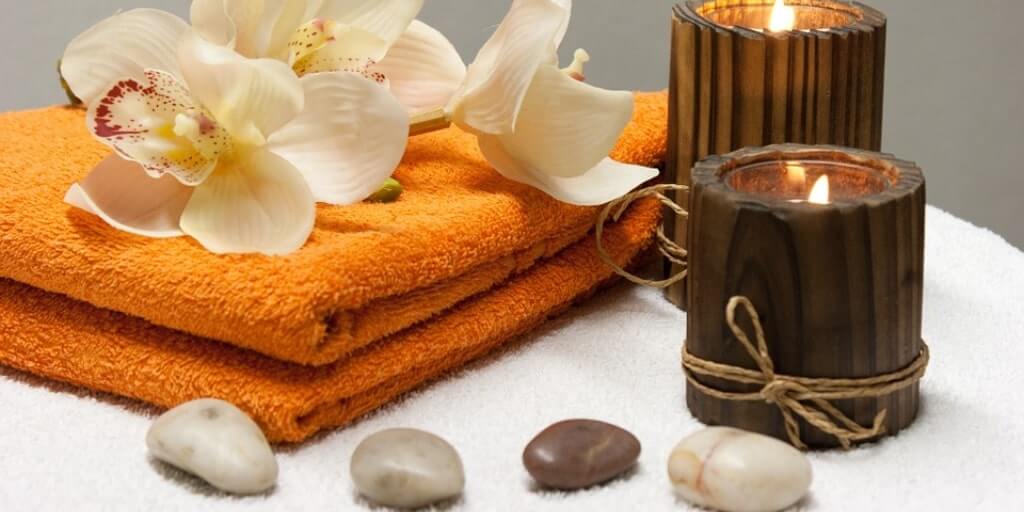1. Full-body mud mask:
Mud is warmed, applied thickly, and the body wrapped in plastic or foil for 20 to 30 minutes. A full treatment takes 60 minutes. Fifteen minutes should be allowed between clients for cleanup and retail selling.
2. Herbal body wrap:
Linen or muslin sheets are heated and soaked in a machine in which herbal pouches or oils have been placed. The body is then covered with towels or rubber sheets, followed by the linen or muslin sheet. Additional sheets and blankets are laid over and the body allowed to rest for 20 minutes. Wet cloths need to be constantly placed on the guests’ forehead. Due to the weight of the sheets, technicians can do no more than four to six wraps a day.
3. Paraffin body wrap:
Paraffin wraps generate heat that helps the body perspire, thereby allowing moisture and previously applied nutrients to be absorbed from the skin surface into the body. The paraffin may be used alone or in conjunction with mud or seaweed.
4. Full Body Massage:
These range from the basic Swedish massage to sports, deep tissue, Shiatsu, aromatherapy, and reflexology massages. They are booked for half an hour or a full hour.
5. Full-body facial:
Similar to a facial (hence, the seemingly self contradictory name), this treatment involves cleaning, exfoliation, steam, massage, mask, and finishing lotion, and is booked for 60 to 90 minutes.
6. Body tanning /bronzing:
Exfoliation is followed by the application of a tanning emulsion.
7. Water Therapy:
Hydrotherapy has become the term for treatments using water for professional purposes. Water has been used as a treatment for various diseases since the times of the ancient Greeks.
8. Spot Treatment:
Spot treatments work on a specific part of the body. They include spa manicures and pedicures; hand and foot treatments; scalp treatments; cellulite, anti stress, and bust-firming treatments; back treatments and facials.
9. Exfoliation:
Exfoliation involves rubbing, polishing, or scrubbing the skin, or using enzymes on it, to remove dead skin and dirt. Removing dead cells allows the skin to more easily accept moisturisers and other skin treatments.
10. Ayurvedic Message:
Ayurvedic Massage is known as Abhyangam in Sanskrit. According to the Ayurvedic Classics Abhayngam is an important dincharya (Daily Regimen) that is needed for maintaining a healthy lifestyle. The massage technique used during Ayurvedic Massage aims to stimulate the lymphatic system.
11. Burmese massage:
Traditional Burmese Foot Massage, Burmese massage has its ancient origins from Thai, Chinese and Indian medicine. Currently, Burmese massage also includes the use local natural ingredients such as Thanaka, which helps to promote smooth skin and prevents sunburn.
12. Thai massage:
Traditional Thai massage (Nuad Boran) is generally based on a combination of Indian and Chinese traditions of medicine.
13. Turkish bath massage:
In traditional Turkish baths, massage involves not just vigorous muscle kneading, but also joint cracking.
14. Ashiatsu Japanese Message:
In ashiatsu, the practitioner uses their feet to deliver treatment. The name comes from the Japanese, ashi for foot and atsu for pressure.[34] This technique typically uses the heel, sesamoid, arch and/or whole plantar surface of foot, and offers large compression, tension and shear forces with less pressure than an elbow, and is ideal for large muscles, such as in thigh, or for long-duration upper trapezius compressions.
15. Acupressure:
Acupressure is a technique similar in principle to acupuncture. It is based on the concept of life energy which flows through “meridians” in the body. In treatment, physical pressure is applied to acupuncture points with the aim of clearing blockages in those meridians.
